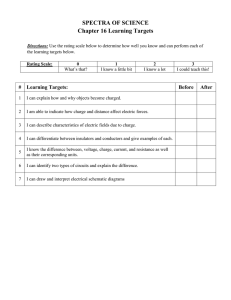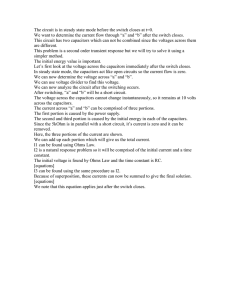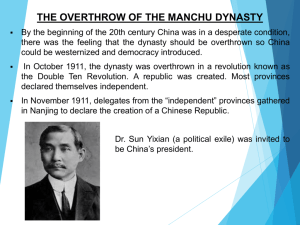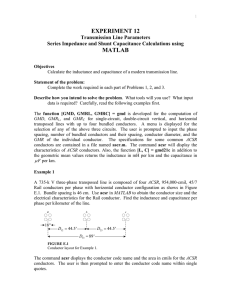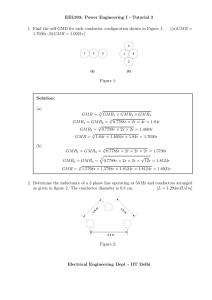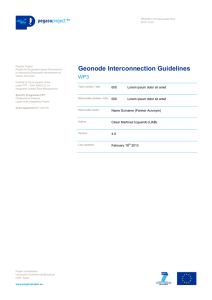ECE 421/521 FALL 2013 - MIDTERM EXAM 2
advertisement
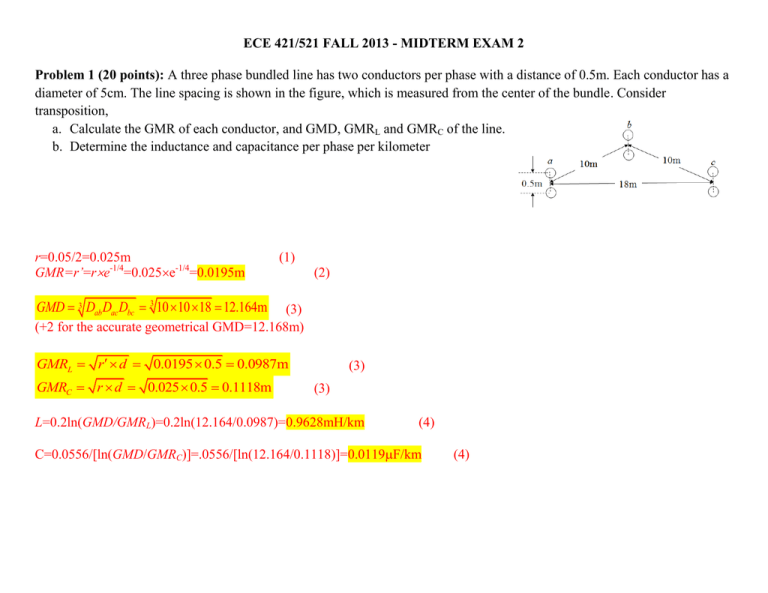
ECE 421/521 FALL 2013 - MIDTERM EXAM 2 Problem 1 (20 points): A three phase bundled line has two conductors per phase with a distance of 0.5m. Each conductor has a diameter of 5cm. The line spacing is shown in the figure, which is measured from the center of the bundle. Consider transposition, a. Calculate the GMR of each conductor, and GMD, GMRL and GMRC of the line. b. Determine the inductance and capacitance per phase per kilometer r=0.05/2=0.025m GMR=r’=re-1/4=0.025e-1/4=0.0195m (1) (2) GMD 3 Dab Dac Dbc 3 10 10 18 12.164m (3) (+2 for the accurate geometrical GMD=12.168m) GMRL r d 0.0195 0.5 0.0987m GMRC r d 0.025 0.5 0.1118m (3) (3) L=0.2ln(GMD/GMRL)=0.2ln(12.164/0.0987)=0.9628mH/km (4) C=0.0556/[ln(GMD/GMRC)]=.0556/[ln(12.164/0.1118)]=0.0119F/km (4) Problem 2 (30 points): A 60-Hz 765kV 3-phase transmission line is 400km long. The distributed line parameters are L=0.873mH/km, C=0.0149F/km, r=0 and g=0. The transmission line transmits 2000MW and 600Mvar at 765kV at the sending end. a. Determine the transmission line surge impedance ZC, phase constant , wavelength , surge impedance loading SIL, and ABCD constants. b. Find the receiving-end line-to-line voltage magnitude and three-phase complex power. c. Determine voltage regulation. a. =260=377rad/s b. Let VSp=765/30=441.7kV -3 z=jL=j3770.87310 =j0.3291 /km -6 =242.1 /km ZC =√ √ (1) SS3=2000+j600 MVA (1) ISp=(SS3/VSp/3)*=[(2000+j600)106/(765103)/3]* (2) =1509.4-j452.8 =1575.9-16.70o A -6 y=jC=j3770.014910 = j5.61710 S/km √ (1) IRp=-CVSp+AISp=1291.6-j1331.7 =1855.2-45.9o A (1) SR3=3VRIR*=2000+j550.7=207.415.4o MVA (2) (2) (2) A=D=cosl=cos(0.00136400)=0.8557 (1) VRp=DVSp-BISp=321.2-j189.1=372.7-30.5o kV (2) =2/=4621 km (1) (3) B=jZCsinl=j242.1sin(0.00136400)=j125.253 (2) C=j/ZCsinl=j/242.1sin(0.00136400)=j0.00214 S (2) |VRl|=3|VRp|=645.6kV c. Open circuit at receiving end VSp=AVRp+BIRp=AVRp VRp=VSp/A=516.1kV VR=(516.1-372.7)/372.7=38.48% (2) (2) (3) Problem 3 (20 points): Short answers a. Which of the following will increase the resistance of a transmission line? i. Increasing line temperature ii. Moving from a 60Hz ac system to a 50Hz ac system. (decreasing resistance due to the skin effect) i (R=kl/A) (2) b. A three-phase transmission line has 2 bundled conductors per phase. Which of the following may increase the capacitance of the line? Briefly explain why. i. Moving farther away from the ground (If height, then C) ii. Increasing the distances between its three phases (If GMD, then C) iii. Increasing the distances between the two bundled conductors of each phase (If GMRC, then C) iii (2) reasons (2) C 0.0556 F/km GMD ln GMRC c. Determine the ascending order of the wavelengths of the following lines, and briefly explain why. i. A transmission line with 3 bundled conductors operated at 60Hz ac ii. A transmission line with 3 bundled conductors operated at 50Hz ac iii. A transmission line with 2 bundled conductors operated at 60Hz ac iii < i < ii (2) 1 f LC 1 kC f k L ln(GMD / GMRL ) ln(GMD / GMRC ) ln GMD ln GMRC ln GMD ln GMRL f k L kC ln GMD ln n r d n 1 ln GMD ln n Ds d n 1 f k L kC If f then (2) -1/4 Ds=re <r GMRL<GMRC the numerator of <1. If the bundling number n then GMRLGMRC. Then the numerator of 1 () (2) Ds r d. For a lossless line, consider the real power P delivered to its receiving end. Are the following statements true or false? Briefly explain why. i. If P= SIL, the voltage and current at any point along the line must be constant in magnitude. ii. If P> SIL, the voltage at the receiving end must be lower than the voltage of the sending end. iii. If P< SIL, the voltage at the receiving end must be higher than the voltage of the sending end. i: false when QR0 (1) ii: false when, e.g., PFR is leading (1) iii: false when, e.g., PFR is lagging (1) Q is unknown (1) e. Compared with using shunt capacitors for var compensation, what are the major advantage and disadvantage of using series capacitors? Advantage: Self-regulating, i.e. generating more var with heavier power current flows (2) (If answering improving stability, receive 1 point) Disadvantage: sub-synchronous resonance (2) Problem 4 (40 points): A 60-Hz 500kV 3-phase transmission line is 300km long. It has ZC=250 and =0.0013rad/km. A lossless line is assumed. The line delivers 1000MVA at 0.8 lagging power factor to the receiving end. a. Determine the total Mvar and capacitance per phase for the Y-connected shunt capacitors installed at the receiving end to keep the receiving end line-toline voltage at 475kV when the sending end voltage is 500kV b. Instead of using shunt capacitors, consider installing series capacitors at the midpoint of the line. Determine the percentage compensation and capacitance per phase for series capacitors to keep the receiving end line-to-line voltage at 475kV when the sending end voltage is 500kV c. Respectively for the conditions in questions a and b, determine the theoretical steady-state stability limit and the practical loadability limit with max=30o for the line d. (ECE521) Respectively for the conditions in questions a and b, draw the sending and receiving end power circle diagrams for the transmission line. In two diagrams, indicate the operating conditions that correspond to the theoretical and practical limits calculated in question c. a. SR(3)=1000cos-1(0.8)= 100036.87o =800+j600MVA (2) l=0.0013300=0.39rad=22.35o (2) (3) P(3 ) | VS ( L L ) || VR ( L L ) | |B| sin | VS ( L L ) || VR ( L L ) | sin X (2) QR (3 ) | VS ( L L ) || VR ( L L ) | |B| cos | VR ( L L ) |2 |B| | A| b. Let X 'new X ' X C 2 X ' Z ' j( X ' X C 2 ) j X ' j 95.047 Y' j 2 tan( l / 2) j 0.00158 S ZC A 1 Z 'Y ' 1 0.075 2 B Z ' j95.05 (1) SR* (3 ) 4750 IR 0.972 j0.729 kA VRp 274.240 kV 3VRp* 3 VSp AVRp BI R (1 0.075 ) 274.24 j 95.047 (0.972 j0.729) (274.24 48.72 ) j92.386 | VS ( L L ) || VR ( L L ) | | VR ( L L ) |2 cos cos X X VSp (274.24 48.72 )2 (92.386 )2 500 / 3 kV =0.2735 (1) SC1(3)=(j171.7-j600)=-j428.3Mvar (2) XC1= (1) C1 (2) X’new=0.2735X’=26.00 (1) X C 2 0.7265 X ' 69.05 % Compensation = Xc2/X’=1-=72.65% (2) 1 C2 38.41 F (2) 2 f X C 2 (1) c. for question a: CS X’=95.05 | A || VS ( LL ) |2 0.925 5002 B A 90 j 2433 (1) 95.05 |B| | A || VR ( LL ) |2 0.925 4752 CR B A 90 j 2196 |B| 95.05 |V || V | 500 475 R S ( L L ) R ( L L ) 2498.7 |B| 95.05 |V || V | 500 475 Theoretical: P3 max,T S ( L L ) R ( L L ) 2498.7MW X 95.05 |V || V | 500 475 Practical: P3 max,P S ( L L ) R ( L L ) sin 30 1249.3MW X 95.05 2 Diagram (1) (2+2) for question b: B=jX’new=j26.00 A=1-0.075=0.9795 for question b: X’new=26.00 Theoretical: P3 max,I |V || V | 500 475 S ( L L ) R ( L L ) 9135MW X new 26.00 |V || V | 500 475 Practical: P3 max,P S ( L L ) R ( L L ) sin 30 4567MW X new 26.00 2 (2+2) B=Z’=jX’=j95.05 A=1-0.075=0.925 0.9795 5002 CS 90 j 9418 26 0.9795 4752 CR 90 j8500 26 500 475 9135 26 Diagram R d for question a: ( ) (1) ( ) (1) (1) (1) (1) (1) (1) (1)

